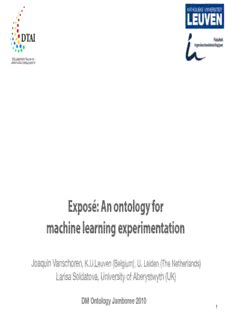
Exposé: An ontology for machine learning experimentation PDF
Preview Exposé: An ontology for machine learning experimentation
Exposé: An ontology for machine learning experimentation Joaquin Vanschoren, K.U.Leuven (Belgium), U. Leiden (The Netherlands) Larisa Soldatova, University of Aberystwyth (UK) DM Ontology Jamboree 2010 1 Exposé: An ontology for machine learning experimentation Joaquin Vanschoren, K.U.Leuven (Belgium), U. Leiden (The Netherlands) Larisa Soldatova, University of Aberystwyth (UK) DM Ontology Jamboree 2010 1 Overview Ontology lessons Exposé ontology Use cases Ontology lessons What did we learn from other ontologies Ontology design • Start from accepted classes & properties (top-level ontologies, e.g. OBI, RO) • If possible, reuse prior ontologies to build on their knowledge/consensus • Use ontology design patterns: reusable patterns for recurrent problems • http://ontologydesignpatterns.org • Check clarity, consistency, extensibility, minimal commitment Ontology recap: OntoDM (Panov et al., ’09,’10) • Aim: unified framework for DM research, builds on BFO plan specification plan process DM algorithm algo impl algo appl achieves has output model, has part has input pattern, clustering,... generalization task classification, realizes pattern mining,... component dataset kernel, data types, constraints distance function,... feature types,... Ontology recap: OntoDM (Panov et al., ’09,’10) • Aim: unified framework for DM research, builds on BFO plan specification plan process DM algorithm algo impl algo appl achieves has output model, has part has input pattern, clustering,... generalization task classification, realizes pattern mining,... component dataset kernel, data types, constraints distance function,... feature types,... Ontology recap: DMOP (Hilario et al., ’09) • Model internal structure of learning algorithms DM object has hyperparameter implements p=? hyperparameter classification algorithm operator specifies model complexity specifies has model complexity input type has opt. control strategy output type control strategy problem algorithm dataset assumes assumption has optimization optimization strategy model optimization strategy problem + p=? has constraint has obj. funct. - p=? regularization model model decision parameter structure parameter boundary induction loss function cost function constraint Ontology recap: DMOP (Hilario et al., ’09) • Model internal structure of learning algorithms DM object has hyperparameter implements p=? hyperparameter classification algorithm operator specifies model complexity specifies has model complexity input type has opt. control strategy output type control strategy problem algorithm dataset assumes assumption has optimization optimization strategy model optimization strategy problem + p=? has constraint has obj. funct. - p=? regularization model model decision parameter structure parameter boundary induction loss function cost function constraint Ontology recap: DMWF (Kietz et al., ’09) • Reason about KD operators: in/outputs, conditions/effects (SWRL rules) Thing attribute_value_table categorical,... meta-data operator reader writer data table modeling model model processing processing evaluation produces uses data model report IO object
Description: